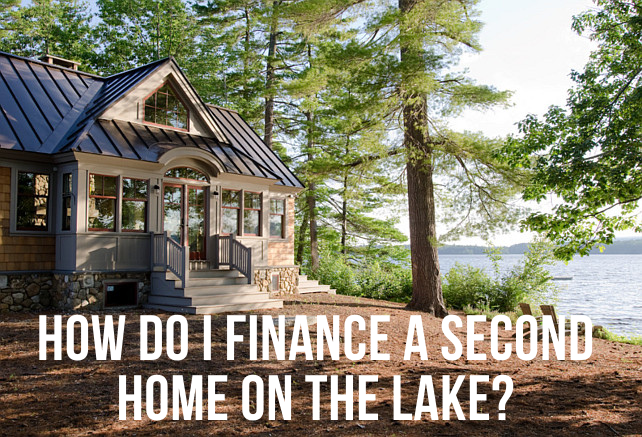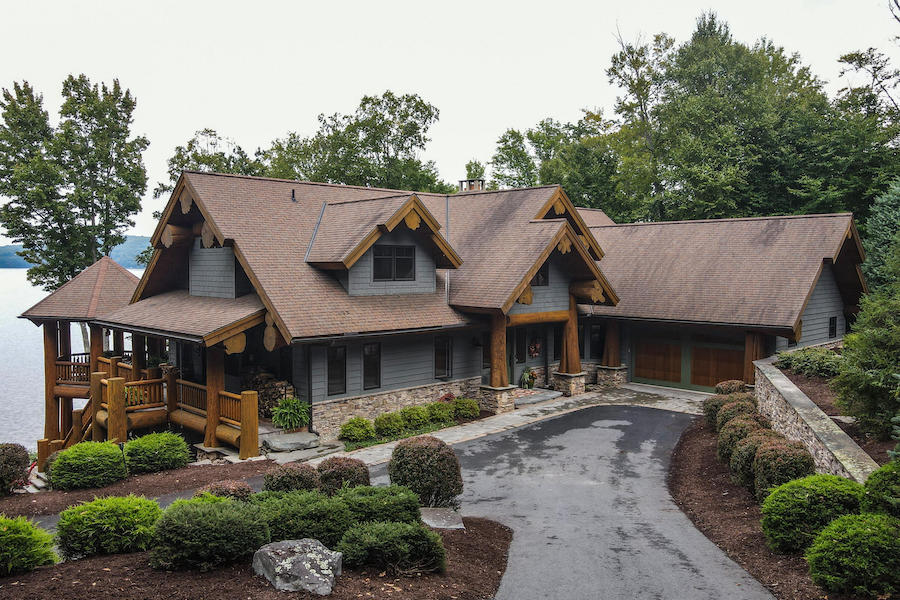
Buying a second home—whether for an investment or as a vacation getaway—can be a wise financial move if you plan to use it several times a year and rent it out for additional income the rest of the time. But buying a second home is not like purchasing a primary residence. The requirements for financing a second home purchase are stricter than for primary residences. There are also additional expenses and tax implications that apply specifically to second homes and vacation properties that are different from those for primary homes and investment properties.
Here’s everything you need to know about financing a second home on the lake…
How your first home can help finance your second home:
First things first, you will have to make sure you can afford a second mortgage. Ideally you would have paid off your first mortgage fully, or at the very least made, consistent, timely payments. Second mortgage interest rates on average tend to be about a quarter of a point to a half a point higher than the interest rates on first mortgages. You’ll have to prove to the bank that you can cover both your first and second mortgages with money to spare.
If you have a large amount of equity in your first home, you could obtain enough money to pay for most—if not all—of the cost of a second home. Two options include…
Cash-Out Refinance-
A cash-out refinance is when you replace your current mortgage with a new, larger mortgage so you can access cash by accessing your home equity. Because a cash-out refinance is taken out on a primary home mortgage, you could borrow more money and at a lower rate than if you took out a secondary mortgage loan—such as a home equity loan or home equity line of credit (HELOC).
With a cash-out refinance, you could get a loan of up to 80% to 85% of your first home’s value. However, you should watch for closing costs, which can lower the amount of cash you receive by several thousands of dollars.
Home Equity Loan or HELOC-
Home equity loans and HELOCs rely on the equity in your primary home as collateral to obtain money, either as a lump sum loan or with a credit line that can be used over time. With a loan, you’re receiving the money all at once and pay a fixed interest rate. HELOCs have variable rates and are more often used for a variety of expenses over time.
With both options, you might be allowed to take out a higher loan-to-value than you would for a cash out refinance—possibly 85% to 90%.
If you want to pay for the second home in cash, a combination of refinancing funds plus savings, a personal loan or a 401(k) loan could provide all you need. However, if that’s not enough, a second home mortgage is the likely best option.

Vacation Homes VS Rental Properties:
The tax implications are vastly different when you’re renting out your old home, as opposed to keeping it as one of two personal residences. If you go with the latter, the interest on your second mortgage is tax-deductible. But, if you’re renting out your first home and generating business income from it for 14 or more days per year, you won’t be eligible to deduct all of the mortgage interest on that second home. You can, however, deduct expenses related to the upkeep of the property during the days tenants occupy it each year.
With this being said, along with complying with local landlord laws, renting out your second property can be a headache. You have to be prepared for maintenance issues at any time. Of course you can hire a rental management company but this comes at a steep price. It would be a good idea to talk to a financial advisor who’s versed in home costs and mortgages can help you figure out if this venture is profitable or not.
Second Home Mortgage Requirements:
Second home mortgage requirements are much stricter than first ones.
But beyond the down payment rule, guidelines for second home mortgages can be flexible. Borrowers may be approved with:
- A credit score of 680 or higher (typical)
- A credit score of 640-679 (with a down payment of 25% or more)
- A debt-to-income ratio up to 45%
If one area of your application is weaker, you can often compensate for it by being strong in other areas.
For instance, if your credit score is right at 640, you may get approved by making a bigger down payment. Or, if you have a high debt-to-income ratio, you can make up for it with an excellent credit score and 12 months’ cash reserves.
Thanks to this flexibility, it’s possible to qualify for a second home mortgage even without perfect credit or a huge down payment.
Second Home Mortgage Property Requirements-
In addition, the property itself needs to meet certain guidelines. It must be:
- Occupied by the owner some portion of the year
- A one-unit home (not a duplex, triplex, or four-plex)
- Suitable for year-round use
- Belonging solely to the buyer
- Not rented full-time, and is not under a timeshare arrangement
- Not operated by a management company that has control over occupancy
That first rule, stating you must occupy the home part time, is the most important. It means you’re not allowed to finance a property using a second home mortgage and rent it out full time. You yourself need to stay there for part of the year.
If you plan to rent the home full time, it’s considered an investment property — not a second home — and will be subject to higher interest rates and different loan requirements. In addition, the home must be a reasonable distance away from the buyer’s primary residence. It also helps if the house is in a resort community or area. In short, the property must “feel” like a recreational residence, not a rental property posing as one.

Choosing your Down Payment and Loan Terms:
You can buy a first home with just 3% down in many cases. But it takes at least 10% down to buy a vacation home — and that’s if the rest of your application is very strong (high credit score, low debts, and so on). If you have a lower credit score or higher debt-to-income ratio, your mortgage lender may require at least 20% down for a second home. A down payment of 25% or higher can make it easier to qualify for a conventional loan. For the more common fixed-rate mortgage, you can make payments over the course of 30 or 15 years. It all depends on what you can afford to pay each month, though 15-year mortgages come with lower interest rates than their 30-year counterparts.
If you’re purchasing your second home before you retire, a strong case can be made for the 30-year payment plan so there is less of a dent in your budget every month. However, you’ll pay more in interest with a 30-year mortgage than a 15-year mortgage. Keep in mind that qualifying for a second mortgage may require you to refinance your first mortgage to reduce the monthly payments on your first home.
It’s also possible to take out a home equity loan and put it toward a down payment on a mortgage for your second home, which will decrease the mortgage amount on your second home. But giving up home equity has costs, since you won’t be able to use that money to cover yourself in a financial emergency.
Beware of the Additional Costs of a Second Home:
You might be picturing warm sunsets on the beach when you’re ready to purchase a second home. However, you should factor in these costs before your dreams materialize:
- Insurance. In addition to paying more for home insurance due to the location of your house—think flood zones and areas with high wildfire risk—the cost may also be higher if you’re only there part-time or have renters. You may be able to combine some of your policy with the one on your primary residence, such as for liability coverage. But you might not get as much coverage on the second home’s policy since you’re at the second home only part-time and the insurance company might ask you to specify which situations—known as “known perils”—would be covered.
- Furnishings. You’ll need to fill the home with essential furniture and appliances if they didn’t come as part of the home purchase. Plus, you may need to invest in decorations, bedroom and bathroom fixtures and everyday items for the kitchen.
- Maintenance. All homes need maintenance of some sort, including lawn care, snow removal and roof, driveway and patio/deck repair and replacement. Consider these items when evaluating your expected start-up costs, the monthly budget and long-term expense planning.
- Utilities. Electricity, water and other utilities are a constant monthly cost.
- Taxes. Even if your mortgage payment is relatively small, remember that taxes will also increase costs. And, don’t forget to check on tax policies and rates if you’re buying in a different state.

Buying a lakefront second home can be one of the greatest purchases you have ever made. Make sure to talk to a real estate agent before to get an estimate of a property you are interested in. Contacting one of our lakefront specialists can also offer crucial insight into factors like neighborhood safety, school districts, amenities, market prices and other local factors you’d want to consider before shelling out money for your new home. There are many questions you need to consider before buying a second home and it is recommended you talk to a financial advisor to make sure this is the right route for you. Evaluating your finances, creating a budget and talking to those most important to the transaction—namely, your family—can go a long way in preparing you to purchase a second home.
Posted by Scott Freerksen “The Lake Guy”
